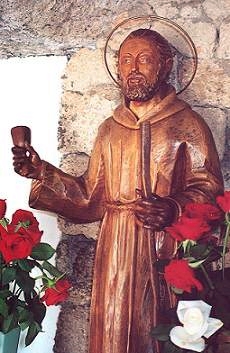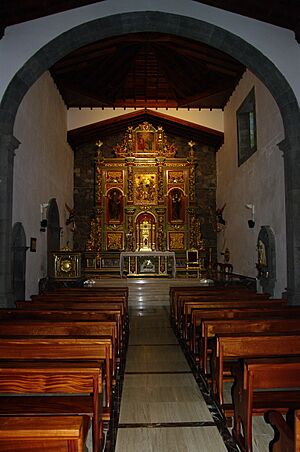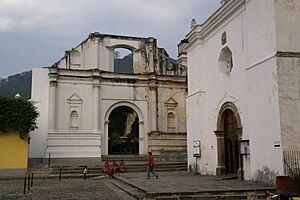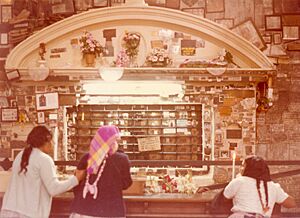Peter of Saint Joseph de Betancur facts for kids
Quick facts for kids SaintPeter of Saint Joseph de Betancur y Gonzáles O.F.B. |
|
|---|---|

|
|
| Religious and missionary | |
| Born | 21 March 1626 Vilaflor, Tenerife, Spanish Empire |
| Died | 25 April 1667 (aged 41) Antigua Guatemala, Captaincy General of Guatemala, Spanish Empire |
| Venerated in | Roman Catholic Church (Canary Islands & Guatemala) |
| Beatified | June 22, 1980, St. Peter's Basilica, Vatican City by Pope John Paul II |
| Canonized | July 30, 2002, Guatemala City, Guatemala by Pope John Paul II |
| Major shrine | Cave of Santo Hermano Pedro and Sanctuary of the Santo Hermano Pedro (Tenerife) and San Francisco Church in Antigua, Guatemala |
| Feast | April 25 |
| Attributes | Holds a walking stick and bell. Occasionally it also represents a spear canary pastor. |
| Patronage | Canary Islands, Guatemala, Central America, catechists of Guatemala, Honorary Mayor of municipalities in the south of Tenerife and Honorary Mayor of Antigua Guatemala, of the homeless and of those who serve the sick. |
Peter of Saint Joseph de Betancur (born March 21, 1626 – died April 25, 1667) was a Spanish saint and missionary. He is also known as Hermano Pedro (Brother Peter). He worked in Guatemala and is famous for helping people.
He is sometimes called the "Saint Francis of Assisi of the Americas." He was the first saint from the Canary Islands. He is also seen as the first saint from Guatemala and Central America because he did his important work there. He started a group called the Bethlehemite Brothers, who helped the sick and poor.
Contents
Peter's Early Life
Peter was born in 1626 in Vilaflor, on the island of Tenerife. He was one of five children. His family was not rich. As a young boy, he worked as a shepherd, taking care of his family's sheep. This was their main way to earn money. He also spent time praying in a small cave near the town of El Médano.
In 1638, his family faced hard times. They owed money, and their land was taken. Peter had to work for the person they owed money to. During this time, his older brother, Mateo, moved to the Americas.
There are stories about Peter's life in Tenerife. One story tells about the cave that now has his name. He used it to shelter his animals in winter. It was also a place for him to pray. Sometimes, he even hid there from pirates, who were common along the coast of the Canary Islands back then.

Journey to the Americas
In 1649, when Peter was 23, he was free from his work. He decided to follow his brother to the Americas. He sailed from the port of Santa Cruz de Tenerife to Guatemala. He hoped to find a relative who worked for the government there. People believe that before he left Tenerife, Peter prayed at the Church of San Francisco de Asís. This church was near the port and many travelers visited it.
When he reached Havana, Cuba, he ran out of money. He worked for a year for a priest who was also from Tenerife. To continue his journey, he worked on a ship that went to Honduras. From there, he walked all the way to Antigua Guatemala. When he arrived, he was very poor. He had to get food from the Franciscan friars who gave bread to the needy. Later, he found his uncle, who helped him get a job in a textile factory.
Helping Others in Guatemala
In 1653, Peter tried to study to become a priest at the Jesuit College of San Borgia. But after three years, he found the studies too difficult and left. He then worked as a sacristan (someone who takes care of a church) for a while. After that, he rented a house in a part of the city called Calvary. There, he started teaching reading and religious lessons to poor children.
Since he could not become a priest, Peter joined the Franciscan tertiary group. This meant he lived a religious life but was not a full monk. He took the name Peter of Saint Joseph. He spent his time visiting hospitals, jails, and helping people who had no jobs. He also worked with young people.
In 1658, Peter was given a small hut. He turned it into a hospital for poor people who were leaving the city hospital but still needed care. People saw his dedication and started to help him. The bishop and governor gave him what he needed.
Three years later, people bought the houses around Peter's hut. On that land, a new hospital was built. Peter himself helped the builders. This hospital was well-equipped and stocked. It was named after Our Lady of Bethlehem. Soon, there was also a shelter for homeless people, a school for poor children, a prayer room, and a place for priests to stay.
The Bethlehemites

Other religious people joined Peter in his work. He taught his first helpers himself. At first, he did not plan to start a new religious group, only to run his hospital. But soon, he wrote down rules for his community. These rules were based on the Rule of St. Augustine, even though Peter was connected to the Franciscans. Women who helped teach the children also followed these rules.
This led to the creation of the Order of Our Lady of Bethlehem (in Spanish, Orden de Nuestra Señora de Belén). The men and women in this group dedicated themselves to caring for the sick. They also worked in other hospitals in the city. Peter continued to be a friend to poor children. The Bethlehemite Order is part of the larger Franciscan family.
Peter's Later Years
Peter also cared deeply for prisoners. Every Thursday, he would go around the city asking for donations for them. He would visit them in their cells. He also collected money to pay for religious services for poor priests. He even arranged for early morning services so that poor people could attend before going to work.
He also thought about the souls of people who had died and were believed to be in Purgatory. At night, he would walk through the streets ringing a bell. He would ask people to pray for these souls.
Peter of Saint Joseph de Betancur died on April 25, 1667, in Antigua Guatemala. He was 41 years old. He had worked very hard and lived a strict life. He was buried in the church of the Capuchin Friars, where his remains were honored for a long time.
Peter spent his life helping those who were often ignored: people with leprosy, prisoners, enslaved people, and native people. He was a pioneer in fighting for Human Rights.
Honoring Saint Peter

Peter was known for his humble spirit and simple life. He showed great kindness to everyone.
He was declared "blessed" (beatified) on June 22, 1980. He was then declared a saint (canonized) on July 30, 2002, by Pope John Paul II. During the ceremony in Guatemala City, Pope John Paul II called Peter the "first Tenerifean and Guatemalan saint." He said Peter showed a valuable way of life that we should remember and try to follow.
The Catholic Church recognized the healing of a child with a serious illness as the miracle needed for Peter to become a saint. This child was from Vilaflor, Peter's hometown.
Peter's tomb is in the San Francisco Church in Antigua Guatemala. The Cave of Santo Hermano Pedro is in the south of Tenerife. It is a very popular place for people to visit and pray. Inside the cave, there is a wooden statue of Peter. Another important place to honor him is the Sanctuary of the Santo Hermano Pedro, built where he was born in Vilaflor.
His special day is April 25, but it is often celebrated on April 24 because April 25 is also the day for Mark the Evangelist. In Tenerife, he is also celebrated on June 29, which is the feast day of Peter the Apostle.
Peter's Legacy
Peter of Saint Joseph de Betancur is seen as a great missionary in the Americas. His social work, helping the most vulnerable, is compared to the work of Mother Teresa centuries later.
He is sometimes given credit for bringing the Christmas Eve posadas procession to the Americas. In this tradition, people dress as Mary and Joseph and go from house to house, asking for a place to stay. This custom then spread to Mexico and other Central American countries.
Peter was also known for performing miracles, like healing sick people very quickly. He was also devoted to the idea of the Immaculate Conception (Mary being free from sin from birth), long before it became an official teaching of the Church. He also showed great care for the souls in Purgatory and lived a life of self-sacrifice.
See also
 In Spanish: Pedro de San José de Betancur para niños
In Spanish: Pedro de San José de Betancur para niños
- Bethlehemite Brothers
- List of saints of the Canary Islands


